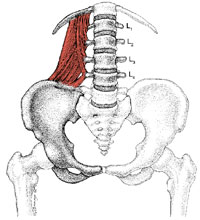A bit about the QL...
/
As we have said in previous posts, though they can’t act independently we like to think to think of the QL as having two divisions. The lower division arises from the medial portion of the iliac crest and adjacent iliolumbar ligament and inserts onto the transverse processes of the lumbar vertebrae, in the coronal plane from lateral to medial and in the saggital plane from posterior to anterior. The upper division arises from the lumbar transverse processes of the upper 4 lumbar vertebrae and insert into the inferior border of the 12th rib, running in the coronal plane from medial to lateral and in the saggital plane from anterior to posterior; about half of the fascicles of this second division act on the twelfth rib and the rest act on the lumbar spine.
The QL is primarily a coronal plane stabilizer causing lateral bending to the ipsilateral side when the foot is planted as well as posterior rotation of the lumbar spine on the weight bearing side. When acting unilaterally without the ipsilateral foot fixed on the ground, it can raise the ilia on the side of contraction. It is active during single limb support during stance phase of gait on the contralateral side (along with the external oblique) to elevate the ilium. This is coupled with the ipsilateral anterior fibers of the gluteus medius and minimus pulling the iliac crest toward the stable femur. Sahrmann states “the QL is optimally situated to provide control of lateral flexion to the opposite side via its eccentric contraction to provide control of the return from lateral flexion via its concentric contraction. The muscle is also positioned to play a role in the rotation that occurs between the pelvis and spine during walking”.
Acting bilaterally, it extends the lumbar spine, deepening the lordosis and acting to limit anterior shear of the vertebral bodies.
It is also able to stabilize the 12th rib during forced expiration, thus acting as an accessory muscle of respiration. This fixation is important when we need to superimpose pelvic movements upon it. Furthermore, it increased activation in response to increasing compression in static upright standing postures.
Here is a video of a low back screen we often use




















